Getting to the Heat (and the Cold) of the Matter: Contrast Therapy 101
If you’re familiar with our XPT lifestyle, you’ll know that one of our three main pillars is Recover (the other two being Breathe and Move). We typically divide our recovery approach in two.
First is passive recovery, which is basically rest and any kind of therapy in which a practitioner subjects you to a modality like massage. This is certainly necessary and useful, but we like to prioritize active recovery as well. This is a fancy way of saying that you’re becoming a participant and proactively doing something that will help you to bounce back more quickly and fully from your training and the demands of daily life.
Such techniques include mobility/soft tissue work, nutrition, low intensity movement or activity, breath work and, for our purposes in today’s topic, hot and cold water therapy—also known as contrast therapy.
What is Contrast Therapy?
What is contrast therapy? What do we mean when we write this term? What we’re getting at is the combination of exposure to both heat and cold to illicit certain physiological responses at different times and for varying purposes.
The use of contrast therapy is found in cultures across the world, from the traditional onsens in Japan, to plunge pools and saunas in Scandinavia, to the sweat lodges of Native American tribes. We’re going to get to some of the scientifically proven or indicated benefits in a moment, but the main reason that having a hot and cold practice has perpetuated across country and continent lines and for centuries is simple: it works!
People feel better when they take a soak in hot water or get in a sauna, and then add in some manner of cold exposure (or vice versa). So, they’ve kept doing it. Our country’s adoption of this ritual has been much more recent, but people are starting to wake up to the fact that getting hot and then cooling off can improve their recovery, boost their energy levels, bust stress, and so much more.
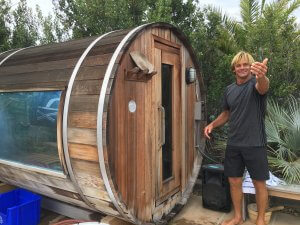
Looking at the Physiological Benefits of Cold and Heat Therapy
From a physiological standpoint, we know that we cannot simply expose ourselves to an appropriately dosed stimulus and hope that it will promote growth and change. We have to also add in a second element (recovery) to prompt adaptation. That’s why at XPT we like to include some kind of heat and cold exposure in our weekly training programs and during the XPT Experience. It’s one of the many powerful, tested, and true ways to amplify the body’s response to training in the pool, in the gym, and in other settings.
Let’s look at some of the physical benefits that cultivating a regular hot and cold therapy approach can have. Several studies found cold water immersion (CWI) significantly reduced the loss in maximal strength (Bailey, 2007; Leeder 2012; Pournot 2011), while dozens have overwhelmingly shown that a cold plunge reduces delayed onset muscle soreness (DOMS) that plagues so many athletes. On the flipside of the thermal therapy coin, the authors of one significant study discovered that a session in a sauna (heated to at least 212° F) can increase beta-endorphin, growth hormone, and testosterone concentrations while decreasing concentrations of the stress hormone cortisol.
Beyond the purely physical merits, combining heat and cold also offers us some psycho-emotional advantages as well. From a purely anecdotal standpoint, we can use these modalities to increase our resilience and develop mental strength. Former Navy SEAL and ultimate bad ass David Goggins often speaks about the need to “callous the mind,” so we can deal more resolutely with the hardships we create for ourselves in training and the unavoidable problems that crop up in everyday life.
One way to achieve this is to expose ourselves to extreme conditions that force us way outside our comfort zone.
Temperature is Meant to be Experienced
With climate-controlled homes, air-conditioned cars, and thermostat-regulated office buildings, we’ve become used to keeping the temperature around us in a very narrow band. And as, according to the EPA, we spend up to 90 percent of our time in indoor environments, this means we’re becoming increasingly ill-equipped to deal with the much wider temperature variations we encounter outside in nature. It’s not until we take a ski trip to Colorado that we begin to bemoan the cold, or when we drive through Las Vegas on the way to see relatives on the West Coast that triple-digit reading on the thermometer makes us all flustered and cranky.
We can also encounter temperature regulation issues when training/competing outdoors during the summer or winter, particularly if we spend the bulk of our time training in a nicely air-conditioned/heated gym that doesn’t require us to modulate our response to heat or cold. This can lead to excessive sweating and resulting dehydration on an August afternoon or a lack of speed and endurance as we shiver through a run on a chilly December morning. Or, if we show up for a race and the weather doesn’t cooperate with our carefully coordinated and calibrated plan, we might blame a sub-par performance on the conditions. The real issue is our inability to deal with the fluctuating temperatures because we’ve conditioned ourselves to not be able anything other than a comfortable 60 to 75 degrees.
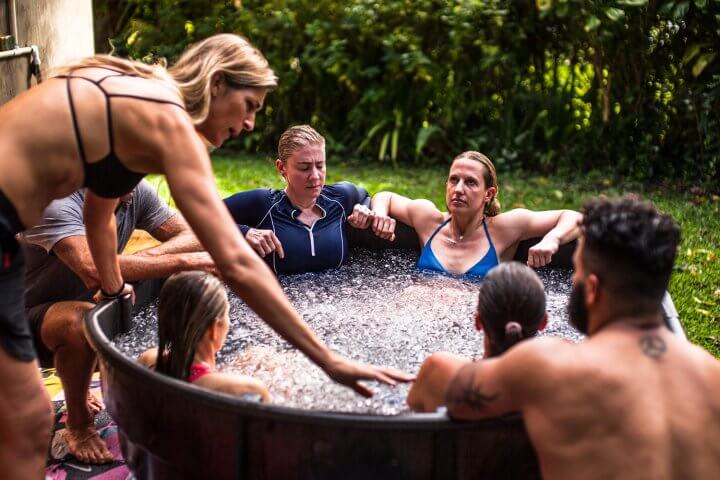
Get out of Your Temperature-Regulated Comfort Zone
Thankfully, the solution to such issues is fairly straightforward. First, we must endeavor to spend more time being active outdoors throughout the year, and merely adapt our choice of gear and clothing to the changing seasons. Second, adding in just two to three contrast treatment sessions a week can dramatically improve our ability to deal with temperature swings, improve our recovery, and increase our mental and physical resilience.
Yes, I know that every blog post you read is asking you to add one (or, in the case of lifestyle blogs, six, eight, or 10 more) thing to your daily routine, and recognize that this can be overwhelming. But adding in contrast therapy requires a minimal time commitment of just a few minutes per session and gives you a lot of bang for your buck.
To get started, all you need to do is simply take a soak in a hot tub or bath or do a sauna session for 10 minutes. Then, follow this with a cool shower that includes a cold blast of 30 to 45 seconds. Do this twice this week. That’s all. And then from there, we’ll add in just a little more progression in the forthcoming part two of this blog series. Now you have your homework, let’s see if you make the grade!
<hr>
Part II: Feeling Hot, Hot, Hot (and Sometimes Cold)
Now that we’ve established some of the benefits of contrast therapy—combining heat and cold exposure—let’s do a deeper dive into how and when to use it, depending on your purposes and goals. We’ll also share a few words of caution to make sure you don’t go too far (particularly if, like me, you’re competitive in every element of your training).
Here are a few different scenarios in which contrast therapy can be beneficial for both body and mind.
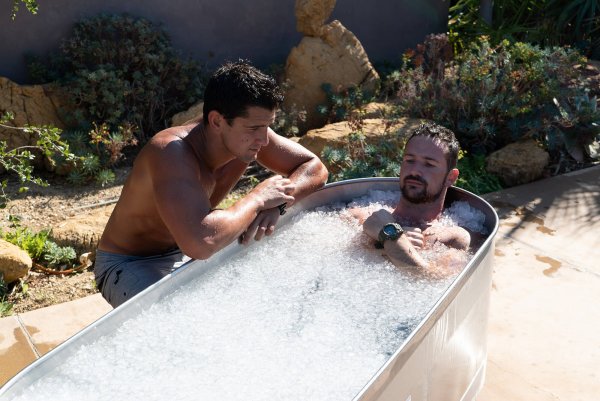
Warming up by Warming Up
Yeah, I know I just used the word “warming” twice in one sentence. But it’s warranted when we’re talking about preparing your body for a hard training session. Doing a quick contrast therapy session beforehand can rev up your nervous and cardiovascular systems so they’re ready to tackle the daily workout.
Or, if you’re sore as heck, skip the ice and just do a little heat exposure to ease the tension from those aching muscles.
Hypertrophy
Keep in mind that with any exercise, method, or modality there is always a benefit and a cost. If your goal is to trigger muscle growth (aka hypertrophy), the latest research suggests getting chilly immediately after training can blunt some of the acute inflammation prompted by your training that triggers muscle repair. As XPT Advisor Dr. Andy Galpin says, “You are either optimizing or adapting.” We recommend pushing your cold therapy to later in the day or onto a rest day if you are training for strength or hypertrophy gains.
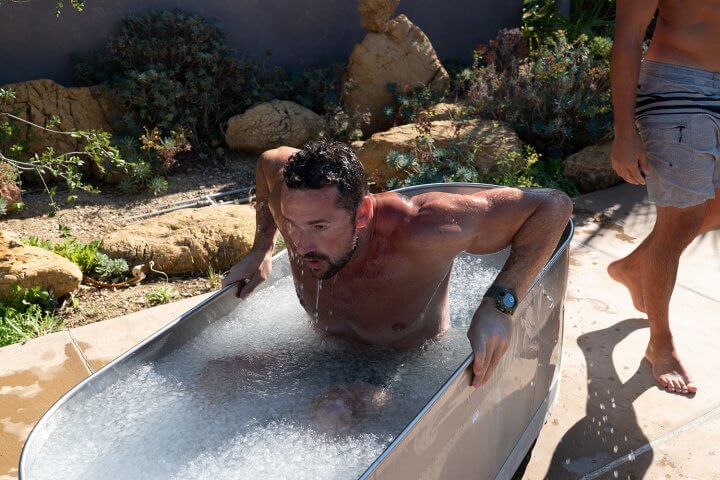
Evening Wind-Down
Cycling between heat and cold at night can be a great way to reset your autonomic nervous system and downshift from a sympathetic “red alert” state into a parasympathetic “chill out” one (cold related pun intended). That said, your body can view going to absolute extremes with either component of contrast therapy as a threat, keeping you stuck in a high sympathetic state. Dial down the temperature a bit on your sauna and go a little warmer on your CWI than you normally would. Or, just go for the milder combo of a warm bath and cool shower instead. Your sleep duration and quality will likely improve.
Thermic Stress
Sometimes we don’t want to treat contrast therapy as a mere recovery aid, but as its own stressor. In this case, you can dial up the temperature on your heat and drop it down for the cold. Or, do several “rounds” as if you were doing interval trainer on a rowing machine, Ski Erg, treadmill, or bike.
Alternatively, try increasing the time you spend exposed to heat and cold, without going too far. By using contrast therapy as your training, you can improve resilience and also cardiovascular health. If you start to feel woozy or light-headed in the sauna or start shivering uncontrollably in the ice, it’s time to stop and get out.
Recovery Day
When your training schedule tells you it’s time for a day off from intense training, don’t use this as an excuse to just sit on the couch. Instead, go do your sport of choice, play some active outdoor games with your kids and significant other, or tackle some of that overdue yard work. Then, follow it up with a nice long soak in a hot tub, followed by a quick cool off. This way you’ll boost your circulation and get in some low intensity movement, without over-stressing your system. You’ll likely be less sore during the next day’s training than if you’d just done nothing.
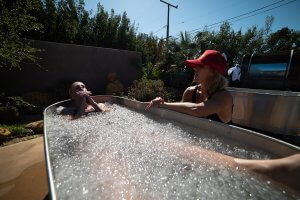
Immune System Booster
Our bodies have cold shock proteins (CSPs) and heat shock proteins (HSPs) that go dormant like your laptop when you put it into sleep mode if you never expose yourself to temperature extremes. Boot yourself back up with a quick sauna session, followed by a cold plunge or ice bath. A single Finnish sauna session has been shown to increase the number of white blood cells, which are responsible for taking out infections. Meanwhile, researchers in both Finland and Germany have demonstrated that regular sauna use reduces the incidence of both cold and flu by up to 30 percent.
Tame Anxiety and Depression & Improve Hormonal Balance
In a memorable episode of Seinfeld, Kramer puts a hot tub in the middle of his living room and encourages Jerry to “take a soak.” Of course, things go wrong when his latest contraption blows a circuit, sending the temperature plummeting and half-killing the zany hipster dufus.
Comedy aside, it seems like Kramer was onto something when it came to contrast therapy and relaxation. Cold water immersion at around 14 degrees Celsius has been shown to mimic or even exceed the positive effects of prescription SSRI drugs, improving feel-good hormone dopamine by 250 percent and norepinephrine by a whopping 530 percent. A paper published in the journal Primates shows that humans aren’t the only ones to take to warm water to quell stress – Japanese snow monkeys ease their primate cares away with a daily soak, too. Good enough for our closest animal “relatives,” good enough for us!
